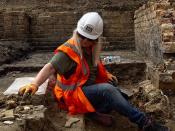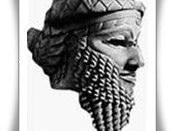Before the middle of the 19th century the existence of the Sumerian and Babylonian people was not known. The first major excavations took place in 1842. This lead to the discovery of the Sumerian and Babylonian people.
The first major archaeological finding were huge temples made of clay bricks. These mountains like structures were like step pyramids rising hundreds of meters above the ground. Archaeologists have found written evidence that these man-made mountains were called Ziggurats and was the center of the Sumerian religion.
Another major archaeological finding was the discovery of the sumerians writing. Huge clay tablets containing strange markings were uncovered. These series of lines was what the Sumerian people called cuneiform. Anthropologists have discovered what most of these symbols mean but some still puzzle them. They made these clay tablets by carving lines in wet clay and then left them out to dry. These clay tablets have given archaeologists so much more about ancient Mesopotamia.
Many other important discoveries were made in Mesopotamia. In 1901, French archaeologists unearthed a huge black stone. On it contained 282 laws set out by Hamurabi. Unfortunately, 34 laws have been lost to us through damage. Strangely there is no rule number 13 as it was considered an unlucky number.
Archaeologists in Mesopotamia have been searching for the fabled Hanging Garden of Babylon. This has been considered one of the Seven Wonders of the World. Weather these gardens really exist or not is still not known and no written records mentioning the gardens has been found. A German archaeologist studied the Babylonian sites for many years and found foundations measuring 30m by 40m which he believes was the bass of the garden.
Archaeologists have played a major role in the discovery of ancient Mesopotamia. They have found hundreds of artifacts...


